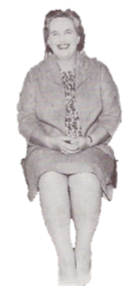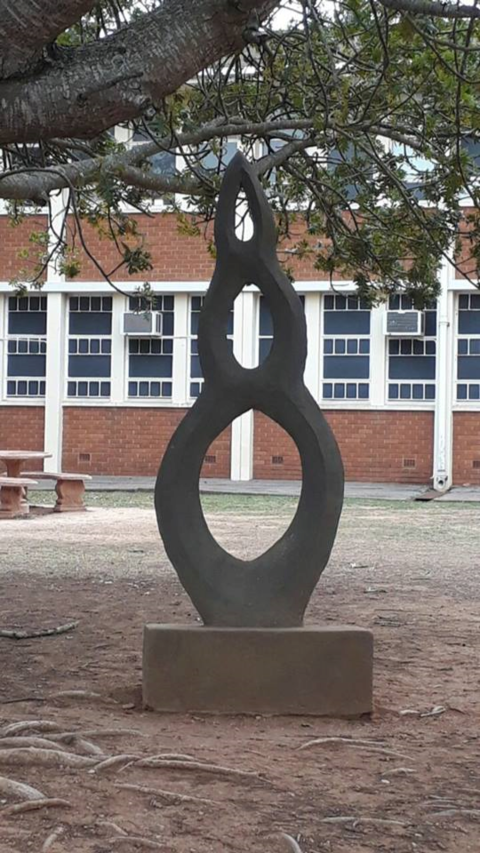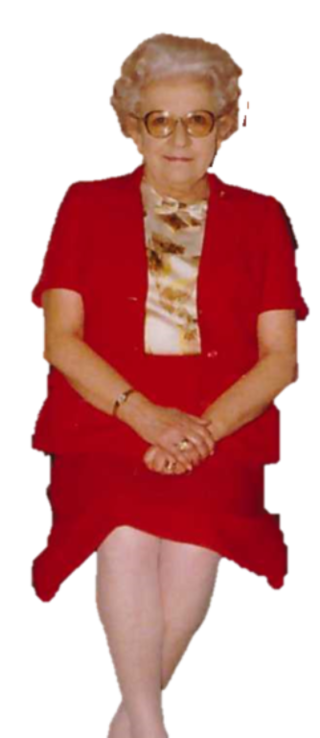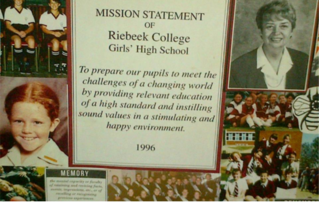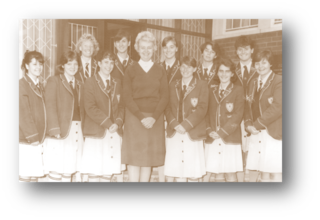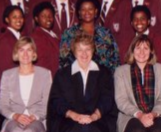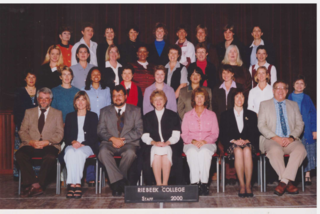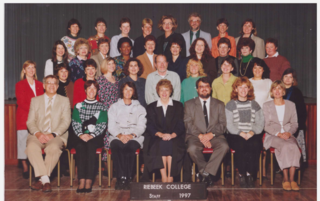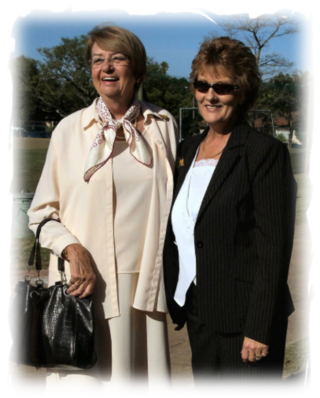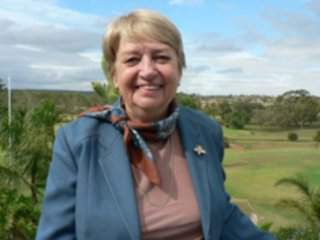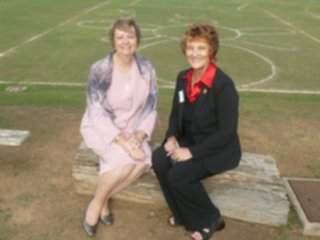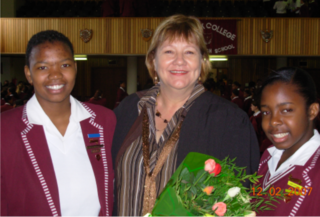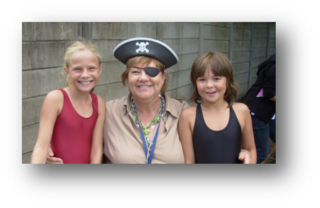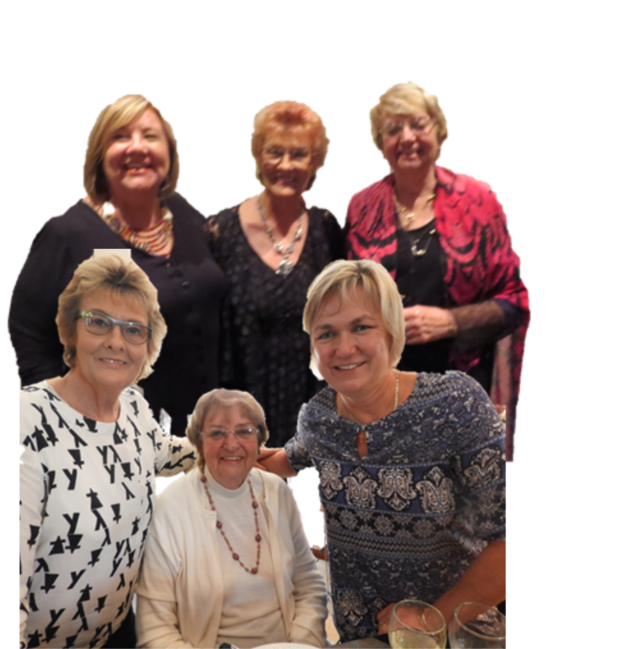1. Miss G. Hearson
1877 - 1880
When Riebeek was founded in 1877, the town stretched roughly from Cannon Street to Durban Street and from Market Street to Cuyler Street. The streets were rough and dusty and there were no street lights until 1978; but the town was vibrant.
Miss Gertrude Hearson was highly qualified and efficient with a personality, Christian example and integrity that set an extremely high standard. She assisted in playing the organ in the NGK and took part in organising local societies. Her discipline was wise and strong. Regular examinations were held and the examinations had to be written on the black board in front of the rest of the class, which proved to be an embarrassing situation disturbed by the giggles of the rest of the class. Annual prize-givings were held and reported on in the local newspaper, the Uitenhage Chronicle. These articles reflect an evening (starting at 7pm) of speeches including reports by the examiners, and fine vocal and instrumental music performances. At 10.30 pm the group would partake in refreshments followed by recitations.

- Miss E.L.Y. Brown
1881 – September 1900
Miss Eleanor Brown travelled here on a boat that was bringing reinforcements for the Zulu war and the officers cheered her as she left the ship – a lone woman travelling to the unknown interior. She came to Riebeek as a teacher and was a most efficient woman with a strong personality. She was the niece of Dr Haig Brown, Headmaster of the well-known school, Charterhouse. Miss Brown’s education had been acquired before the days of women’s colleges, but she had received a thorough training in England. She was most successful in teaching English Literature. She was an enthusiastic Londoner, and the great city lived for her pupils in the vivid descriptions she gave of its places of historical interest.
It was Miss Brown who imported the silver bee that principals wear on special occasions. She intended the bee to be worn by all pupils as a school badge with the motto Ora et Labora but this proved to be too expensive. Miss Brown gave the bee to Miss Brehm, who gave it to Miss Loggenburg. She then presented it to Miss Bartlett and so the tradition was born of the bee being handed to each principal.
It was under Miss Brown’s leadership that Riebeek became a senior and junior school. Riebeek had a music department, an art department, needlework classes, tennis courts, a croquet lawn was laid down, a science lab with the latest equipment . Girls could start taking part in debates and there was the establishing of societies.
Miss Brown was at the helm of the school at a difficult time. She had the qualities of a pioneer and she was prepared to meet the discomforts of an undeveloped land. She displayed tenacity, a strong personality and strict discipline.
By 1896 Miss Brown had much to contend with – increasing number of pupils, no space, no proper classroom facilities, teachers highly qualified with strong personalities and there was irritation and frustration. It was clear that Miss Brown had a passionate temper and the courage of her convictions. She found release by leaving her office and the school and not returning until she had simmered down. Often she would be away during the first week of school and letters from parents appeared in the local newspapers. When admonished by the committee, she showed herself to be a law unto herself and dismissed the whole incident with a curt reply and a flick of her fingers and the pursing of her lips. At times she would resign and then withdraw the resignation. She had an indomitable character and though her health was not good she worked vigorously and robustly wearing down her own resources. She took leave frequently and her visits to England would extend from 3 months to 6 months. Though she was a disciplinarian she did have compassion and a loving spirit. It has been hinted that she had experienced a great personal tragedy, perhaps jilted in love.
During her reign the hours of attendance became fixed. School started at 8:30 in summer and at 9 in winter. School days were five hours long and the girls had a half hour break. In 1900 she felt she could not go on. After a serious illness she applied to be allowed to resign two years before her time of retirement. She never forgot Riebeek. In England, she kept an open house for teacher and pupils.

- Miss M. Houliston
October 1900 - September 1905
Miss Margaret Houliston became the principal at a difficult time in South Africa’s history as the South African War had been the cause of friction. The teachers endeavoured to keep the tension to a minimum and encouraged the girls to show tolerance.
Miss Houliston was a lady of independent spirit. She taught vocal music. During her time it was requested that a typewriter be bought as some children wanted to learn to type but the Committee replied that they had no intention of authorising this.
During her time, Professor James (head of the Music Department) complained of annoyances from his assistants with a deterioration in health as a result and months of discussion followed. There was a complicated system to decide what would be taught: the principal discussed subjects with teachers and then the teachers wrote to the Committee and then the Committee met to discuss the recommendations and then reported back with the whole procedure repeated until consensus was reached.
In June 1903 a boarder was reported for defying the Lady Principal and communicating by means of notes with BOYS!
The School Committee held and exercised much power. They controlled the school: They demanded a written report from the principal each month— and insisted it be written in a book not on a sheet of paper. They controlled the teachers, demanding to know every move they made and where they stayed. They arranged the dates of all functions.
After six months’ leave Miss Houliston was welcomed back in July 1904 and in August tendered her resignation. The resignation was withdrawn in September but on 27 February 1905 she was granted four months’ leave owing to illness in the family. She however resigned as her sister’s illness hindered her return. She later married and lived in Cape Town where she became an active member as Mrs Shannon of the WCTU representing South Africa at the WCTU Convention in Lausanne in 1928 where she was appointed World’s Superintendent of Social and Moral Hygiene.

- Miss G.C. Pollard
October - December 1908
Riebeek College was renowned for its Music Department and its talented teachers had formed an orchestra. During Miss Pollard’s tenure, this orchestra was very much in evidence. Music played a great part in school life. Class singing was a feature and was of a very high standard.
The safe in the principal’s office was burgled and a large sum of money was lost. This affected Miss Pollard so much, she became ill. Miss Pollard took sick leave when, by February 1908, the position of classrooms, at Riebeek was once more a burning question. All rooms at the school were crowded—a large room held two classes and on fine days the large side stoep was used as a classroom. Rooms were rented in buildings as near as possible to the school. The loss of the large sum of money, changing times, congestion in the classrooms and no practical solution nor suggestion of a new building frustrated Miss Pollard. She then stayed away from school and then resigned. She was interviewed and asked to reconsider her resignation. But eventually her contract was terminated by mutual consent.

- Miss L.C. Elton
January 1909 - 1915
Miss Lucy Charlotte Elton was a distinguished, intellectual lady who was a strict disciplinarian – some called her straight-laced. She was dignified, respected and emitted an aura of awe. She was always beautifully turned out – immaculately so! Her iron grey hair and her iron grey spectacles enhanced her personality. She was an excellent teacher of English and imbued her girls with a love of good literature. When she left Riebeek, the school library had 1 000 volumes. She had a quick sense of humour. Before leaving, she had to deal with children who removed the ivory covers from the keys of the pianos.
During a week’s leave, Miss Elton visited Cape Town and accepted the post of principal of the Good Hope Seminary from January 1916. She had given direction to the curriculum and brought stability. Great emphasis was placed on the classics and English Literature.

- Miss A. E. Thomson
January 1916 – 1922
Mrs Agnes Ellen Thomson had had a distinguished career. She belonged to a very academic family. Her brothers were studying for their degrees when Agnes E. Lewis decided she would do likewise. Much of her work was done by private study. In 1885, she gained a B.A. degree, being the first woman to take a degree in South Africa. She proceeded to Cambridge University and in 1889, completed her Masters Degree. No woman at that time was allowed to receive such a degree so she had to wait sixty years for the authorities to confer the M.A. degree on her – in abstentia. Her brother was Professor C. E. Lewis, founder of the Old South African College – now the University of Cape Town.
She came to teach at Riebeek in 1891, her subjects being Latin, French and Greek. Miss Lewis remained at Riebeek for 3 ½ years. In 1895, she left to join the staff of the Good Hope Seminary. Three years after she returned to Uitenhage in 1898 as the wife of Mr Peter Thomson, the Town Clerk. She has one daughter, Joyce, who attended Riebeek and was taught by her mother. She resumed teaching at Riebeek in 1903 when her husband became an invalid. She had been honoured by the Town Council when she was chosen to plant one of the oak trees in front of the Town Hall. These are still there and are called the Coronation Oaks.
The teachers were very formal in their approach to one another. No first names were used.
In an attempt to alleviate the position of accommodation and other educational difficulties, the Department of Education recommended that Riebeek and Muir be amalgamated. Mrs Thomson promptly denounced the proposal as absurd.

- Miss W. Linnell
April 1923 - March 1930
When Miss Linnell applied for the post, she was interviewed by Miss Elton, then a Department of Education Inspector.
Miss Linnell was the last of the “English” Heads – she was stately of stature with iron grey hair. Upon a passing visit to Riebeek by the Prince of Wales, the Prince got out of his car and walked up to Miss Linnell, shaking hands with her. She gave a beautiful curtsey.
There had been a system of Head Girl and Prefects in the boarding house and the Head Girl became automatically Head Girl of the school. Dorothy Hill, a boarder, was head girl in 1923, but Vera Webber a day girl, became the first “Day” head girl with some prefects in 1924 and so commenced an official prefect system at the school. This was also the year that the school was divided into two Houses for sporting activities.
Miss Linnell resigned and retired to Cape Town where she later married Mr Crawford.

- Miss G. A. Schmidt
April 1930 - March 1944
Miss Gladys Amy Schmidt was born in Kimberley and lived there during the Siege, October 1899 to February 1900. Her father was in the Diplomatic service so she spent 2 ½ years in England, returning to Kimberley in 1904. She had travelled very widely – Europe, America and Canada. She had been a brilliant scholar, which made her intolerant of low standards.
She matriculated in 1908, was dux medallist and was awarded the Victoria Memorial Scholarship, awarded to the girl obtaining the highest place in South Africa in the examination. In 1911, she graduated at the Cape University.
In 1926, she went overseas on the Interchange Teacher’s Scheme. She had the honour of being the first secondary teacher that England accepted from the British dominions under the scheme. She returned to South Africa in 1927 and became principal of Riebeek in 1930.
Miss Schmidt was a member of a large family of six sisters and one brother, so she knew the problems which beset girls. She could give good advice and was most sympathetic. She had her own home and always had some girls boarding with her.

- Miss J.A.D. Miller
1944-1956
Miss Miller remembered vividly the sunny morning in early April 1944 when she walked hatted and gloved with feelings of apprehension to Riebeek to take over the headship from Miss Schmidt. She was inexperienced in matters concerning School organisation and was fully aware of the knowledge and capacity of her predecessor. “During my regime of nearly thirteen years, I was privileged to have the co-operation and loyalty of members of the staff. Throughout the years there were inevitably many staff changes, but there was always the hard core of experienced teachers, many of whom had served Riebeek College faithfully for many years, and I recall with gratitude their splendid work. In 1955 and 1956 I began to feel that I must move to another school building, and that Riebeek College, facing the challenge of a new school building and Hostel, would benefit by a change. I had been very happy at Riebeek and enriched by the experience gained over the years. I knew, too, that in the very capable hands of Miss E. J. Bartlett, the school would forge ahead and continue to make a very real contribution to the education of hundreds of pupils privileged to attend one of the outstanding schools in the Cape Province.”

Miss E. J. Bartlett
January 1957 - March 1972
“My first glimpse of Riebeek College as a school was, of all places, on the grandstand of the Crusader Rugby Grounds. But what remains clear in my memory, not solely for the distinctive maroon blazer and, in those days, maroon beret, worn with a black gym and the hick black stockings so abhorred by so many generations of schoolgirls. No, it was not the uniform that impressed me; it was the air of relaxed but disciplined enjoyment which spoke so well of the pupils, their teachers and their headmistress.”
Her introduction to the headmistress’s office in the old building in Church Street was overwhelming! The old roll-top desk, the cupboards, the curtained shelves bulged with forms and files and records that she, in-service teacher though she had been for sixteen years, had never dreamt of.
One aspect of the move to the new building was a great disappointment to the girls. No wall decorations were permitted for School Dances. The Matric Farewell organised each year by the Standard 11s is the social highlight of the year and the decorations were outstanding. It was Mrs Bartlett’s habit to be at the school to check the final preparations. One year a principals’ meeting prevented her being there until midday. When she arrived, she found life-size can-Can girls adorning the walls and felt it was necessary to insist on the addition of extra frills. The Muir boys that night removed the frills. She also recalls parading through the unlighted rooms with a torch and recalls one particular couple who came under censure and who, in later years, were happily married. When the mini was in vogue, a pupil arrived at the hall wearing a rather pretty blue silk and lace garter just below the knee and Miss Bartlett reported in 1977 that she still had it! Backless frocks were also a cause of concern and one pupil spent an uncomfortably hot evening dancing in a long sleeved school cardigan. The mini-skirts kept shrinking so Mrs Bartlett was relieved when a request was made for long evening dresses to be worn followed by a request for the matrics to wear white. Thus, an idea that had long been simmering in Mrs Bartett’s mind: In 1968 a Debutante’s Ball was introduced with the matrics wearing long white frocks and carrying a posy of red and white flowers - the matrics were then presented in traditional manner to the Mayor and Mayoress.
Mrs Woods remembers, “During the years of the hall being rebuilt, the matric dances were held in the Town Hall. When I was in matric in 1968, we were the first group of matrics to be introduced as Debutants and were introduced to the mayor of Uitenhage, the late Mr Joe Levy. We each carried a posy of red and white flowers and wore long white dresses. We walked up the red carpet, while our partners waited in a line beside the carpet. Those were the days when the Standard 9 Dance Committee, spent some of their June/July midyear holidays, painting the murals for the walls and making all the décor for the tables. Nowadays, this has become an impracticality for various reasons and the décor and catering is outsourced.”
Miss Bartlett had many fond memories of the happy times spent with the boarders, both at the old and the new hostels – occasions which ranged from all-day picnics at Jeffrey’s Bay to coffee-making sessions in her flat. In this sphere, as well as in school life generally, Mr McIntyre was an important and well-loved figure, especially by the “babies” whose birthday sweets “Mr Mac” never forgot.
Mrs D. W. Hutton April 1972 – December 1987
Mrs Dorothy Hutton was born in Durban. At Natal University she had the distinction of being one of only three women studying for a B.Comm. In 1940. She taught in Durban, moving after her marriage to Lovedale. She then joined the staff of Kaffrarian Girls’ High School for 17 years. Since her appointment at Riebeek, numbers increased drastically and prefabs dotted the playgrounds. One of the biggest changes attributed to her was the office area becoming a more dignified setting for the Head. Riebeek’s own swimming pool was a long-time dream that she brought to reality.
Mrs Dorothy Hutton arrived as the new principal in term 2 of 1972. She came from Kaffrarian Girls’ High School in King Williamstown where she was a highly competent Accounting Teacher and Deputy Principal. Her cross Alsatian, Wendy, accompanied her and remained her faithful companion for many years. Mrs Hutton was an ardent animal lover and always supported the staff, in particular, Mrs Betty van Reenen Lynch who established the SPCA Club at Riebeek College and was an absolute saint for any animal in need.
She was softly spoken and not a lady of many words. Her white hair with a sometime purple tinge and her immaculate outfits led to many saying she dressed like the queen. Her two piece outfits of shirt and jacket in pastel colours were her trademark. Every break, she would be in the staffroom and she had her own chair. Rini, the tea lady (mother of Mama Monica), would bring her tray to her and the teapot would have a knitted tea cosy. Mr Grobler, the caretaker, tended the rose gardens and ensured there were fresh roses for her office, and the prefects had rose duty to cut the roses and place them in her office.
Mrs Hutton never raised her voice but could instil fear in learners with her firm and steady look. She chewed peppermints often. A staff member with a very bright pink slack suit walked into Mrs Hutton’s office and was met with a firm, “Oh!” and Mrs Hutton covering her eyes with her hand. Miss Rose (whom we know as Mrs Hickson) had the misfortune of sitting in Mrs Hutton’s chair in the staff room on her first day. Mrs Hutton merely walked up to her chair and stood in front of Miss Rose until she realised her mistake and moved swiftly.
During Mrs Hutton’s time as principal, two events dominated: the centenarycelebrations and the burning down of the school hall. Mrs Marilyn Woods describes these two events:
“Our Centenary year, 1977, was filled with celebrations. Each junior class performed a traditional dance. My sister, Carol Dodd Rudman, helped with the choreography which included every girl. The teachers, parents and friends of the school pulled together to ensure that the costumes were all authentic . It was a wonderful display of colour and traditional movement from 8 countries. I remember getting a specialist in from the Jewish community to teach the Standard 5s their dance. They wore bright orange tunic tops and black tights and their dance was a real hit! Some of these outfits are still in existence at the school.
The burning down of the school hall in 1979 remains an indelible memory. One of the junior school children told me that her father had said that Mrs Hutton was there in her pyjamas and gown and that she was crying. The late Mr Lex Vincent who was the principal of Muir Primary at the time, alerted the fire brigade and contacted everyone. The inside of the hall was totally destroyed by the fire, leaving only the walls embracing an empty space. The matrics were busy with their final examinations at the time, so the empty shell of the hall housing the remains of all the desks and the grand piano were a macabre reminder of the devastation of the fire. The music corridor behind the hall, the foyer and Harem Walk, which was open to wind and rain at that time, as the wall was made of huge cement bricks with open spaces in the pattern in which they were laid, were all saved. We used to slip and slide down the Harem Walk when it rained as the wind blew the rain through these rather large openings.
The upside of this disaster, was that we managed to get a much better hall, with a balcony and a kitchen on the side near the staffroom and a verandah on the rose garden side of the hall. Rumour has it that it was an act of arson by a young student from Bergsig and that the fire was set behind the interior back wall of the stage, in front of the outside wall of the corridor running behind the hall.
During the re-building of the hall, Riebeek never missed a beat and life at school continued as normal as possible. The art room (Room 10, which today is a classroom) became the staffroom, the upstairs toilets became the staff toilets and the assemblies were held at the end of the Science corridor, with the students lining up on the grounds and partially under the huge Tipuana tree that still stands proudly, today. It was a difficult time in our history, but in typical Riebeek fashion, the students, staff, parents and friends of the school, made it work most effectively. The inimitable spirit of Riebeek and all within her, has always been and will always remain, one of resilience, tolerance and compassion…able to stand up to any test.”
- Mrs N.J. Stear January 1988 – December 2000
Beth Cooper Howell, LaFemme feature columnist, well known journalist and an Old Girl, wrote of Mrs Stear: “We tend to forget what an impact our words may have - especially on the young. I vividly recall my school principal and then English teacher, Natalie Stear, stopping me in the corridor one morning to have a chat. 'Beth,' she said, in her gracious, serious manner, 'I feel very strongly that you must go on to study English and possibly Journalism. It's vital that you expand on this skill of yours. I have great faith in you.' She had much to do and I was one of hundreds of pupils milling the corridor that day; but she knew, as only the wisest of teachers do, that her words would have impact. And they did. I try to remember that whenever I engage ‘with teenagers and children.”
Many remember Mrs Stear’s insistence on the correct register and that no one slouched in assembly. Undeniably, Mrs Stear is respected by all and considered a doyen of education. During her tenure, Riebeek was put on the map and the lives of those she interacted with were enriched. Here Mrs Stear describes her time as principal of Riebeek:
“At the beginning of my tenure at Riebeek College, I was treated to a visit from Mr Sholto McIntyre, a much loved benefactor of the school and past Chairman for many years - known to all who knew him as ‘Mr Riebeek’. The hostel and the school hall bear his name. His opening words were, “Are you she?” I replied, “Yes. Are you he?” He sternly asked, “Which of us is in charge?” I answered, “I am.”
It was my earnest wish to place Riebeek College firmly on the South African map and raise its image in every respect. The school had a proud history and it deserved recognition across all borders. Thus, in my first year, I introduced Founder’s Day – which was to become an annual event at which as many “old girls” as possible could enjoy reunions with girls of the past. At that time I sent for the music of “Let us now praise famous men” (Ecclesiasticus 44) which would be sung as part of the ceremony. I found yellowed sheet music of “The Riebeek March” composed in the 1890’s by Quintus James, a music teacher at the school. Mrs Betty Lynch, head of the music department, played the march while the girls assembled in the hall on Founder’s Day. Miss Marjorie Hill, my own past Headmistress of Clarendon Girls’ High and past pupil of Riebeek College, was the first speaker.
I then designed and ordered our school flag and also introduced House Days, each house bearing its own flag. House Captains had often been left in the background and it was important for them to show their leadership on those occasions. Each one had to select a charity and sell “favours” to the pupils and teachers as a means of collecting for that charity. The favours were designed by chosen girls of that particular house. House Day was celebrated with a speaker chosen by the House Captain.
As there had never been a school magazine (except for one compiled by the Old Girls’ Association many years before and which was discontinued after about five years) the School Committee, under the Chairmanship of Mr Trevor Wait, gave me permission to introduce this in my first year, under the able editorship of Mrs Anne Peltason, who was responsible for the design, as well as the contents of the magazine named “The Riebeek”. This important year book serves as a chronicle of the school’s activities and achievements during the year and acts as a necessary journal for historical research; a showcase for creative talent and a repository of past memories. Since that time other editors and their editorial teams in the school have continued to produce an annual magazine of excellent quality.
Mr Neill Hoare, my first Deputy Head (together with Mrs Sally Potgieter), was an outstanding actor and director. In that first year the musical South Pacific which he directed received much acclaim and there were several musicals to follow over the years, such as Grease and Fiddler on the Roof. Marilyn Woods, who at that time was in charge of the Junior School pupils, also directed many outstanding shows – making sure that she included as many young performers as possible in her well organised and creative productions.
Supported enthusiastically by what was then the School Committee, later to become known as the Governing Body, I was able to introduce other management changes, such as a Finance Committee, and later a part-time Finance Manager to attend to all the administrative financial needs of the school. Mr Hans Schaberg filled that post and immediately introduced a budget and the Pastel Computer program when we moved into the world of the “Model C” school and we no longer were totally reliant on the Department for the financial running of the school. We also appointed a school bursar, the first one being Mrs Pat Slabbert. The Schaberg family played an important role. Not only was their daughter, Helga, a head girl, but she also came back later to teach at the school. Her mother, Ursula, started and ran our school shop, which enabled our school to benefit from the income generated.
There were many other innovations during the 13 years of my charge. At the request of several pupils our school uniform was changed and ‘mottos to live by’ were chosen each year to motivate the girls in their pursuit of excellence. Some of these were, “Do what must be done’; “I respect you and I respect myself”; “Good enough is not good enough”; “Great Expectations”; “Be all that you can be”; “Want to do, can do, will do” and “The Time is Now”.
I wrote a third verse of the school song for the Grade 12s to sing at their valedictory and a mission statement was compiled as a joint effort by our Management teaching staff and Governing Body members at a weekend planning workshop held at St Francis Bay, arranged by the Chairman of the Board, Mr Danie van Deemter. In the last year of my tenure at the school I consulted with the State Herald, Mr Frederick Brownell, to register our school’s coat of arms. Our school had been founded in 1877 and now we had moved into the 21st century. It was time to establish our proud name with the Department of Heraldry. This meant making a few changes to the design according to strict heraldic requirements but our proud name is at last officially documented. Fred Brownell, who redesigned our coat of arms, is the State Herald who designed the South African Flag.
Each year we were delighted with our matric results, together with the results of the rest of the school. Every girl who wrote the Senior Certificate during my 13 years at Riebeek, passed. Two of them had to write supplementary examinations in March – but they are included in that 100% pass rate. From 1998 to 2000 Riebeek College was listed among the top schools in the country by The Sunday Times. In 1998 Kerry-Lynn Thomson (now Botha) was named as the Provincial Matriculant of the Year and among her other prizes she was granted a full scholarship at Nelson Mandela University to study Information Technology. She has now gained her doctorate.
So much ought to be written about the teaching staff. They have played such important roles in maintaining the proud name and traditions of the school, upholding the vision of the mission statement, which they helped to compile. Four of them have become school principals: Mrs Marilyn Woods (Riebeek College Girls’ High), Mr Mike Vermaak (Victoria Park High), the late Mr Finlay Taylor (Queenstown Girls’ High) and the second Mrs Stear (appointed as Head of Riebeek at the beginning of 2017) who was Mrs Butler when she was first appointed at the school and later became my daughter-in-law. Mr Vermaak also negotiated with the Volkswagen Community Trust to give financial aid for our Bridging School to provide academic support in English, Science and Mathematics on Friday afternoons and Saturday mornings.
In 1996 I was elected President of the South African Teachers’ Association (SATA) and during that time we amalgamated with the Association of Professional Teachers in Gauteng to become NUE (National Union of Educators). This is now part of NAPTOSA (National Professional Teachers’ Organisations of South Africa), the second largest teachers’ organisation in the country. During the time of transition in our educational system in the country I served on the Gender Equity Committee, the S.A. Council of Education (SACE), the Education Labour Relations Council (ELRC), The SA Principals’ Association (SAPA) and various transitional committees in the Eastern Cape. I was also able to attend several South African Conferences and two international conferences, one in Geneva, Switzerland, and the other in Helsinki, Finland. When SACE required that every teacher in the country be registered with them I was chosen to be among the top 100 to be the first to receive our certificates from the Minister of Education.
The most momentous change came in 1990, after President Nelson Mandela was freed from prison and the state schools were granted to right to vote to open their schools to all. I was anxious to conduct our election before the matric pupils left for their final examinations as I wanted them and their parents to be part of this historical occasion. The ruling was that 80% of 90% of the parents had to vote and that we had to be given a 90% mandate from those who voted at a formal election. The parents had to be given 14 days’ notice. My lawyer informed me that I could count the day the notices were sent but not the day of the election. On the same day that we received the formal notifications we printed these and handed them to all the pupils in the school. The parents had to return them signed the following morning to indicate that they had read the contents. This was done. Two days before the election it came to the notice of the media (and to me) that Riebeek was to be the first state school in the country to vote. The CEO of SATA phoned me in despair when he read this news in the media. We were in the heart of conservative country and he was sure that our parents would vote “No”. He said it would ruin it for all the other schools as they were bound to take our lead. I told him it was too late; we were going ahead. The outcome was that our parents gave us a 94% “Yes” mandate! That night the Cape Education Department Director of Education phoned me at the school and forbade me to divulge our results to the press. I handed him over to our Governing Body Chairman, Mr Hans Schaberg, who told them that they had no jurisdiction over him and that he was going ahead with the news.
The next morning we were the talk of the country. Newspaper headlines named us as “Riebeek Top of the Class” with other clever titles, while national television and radio interviewed us and we were to be seen and heard in all the news bulletins of the day.
The rest is history. Of all the memorable events and changes that we went through during my charge, I am proudest of that time when we and all our parents opened our arms and our hearts to young girls irrespective of their colour or creed.”
- Miss L. Bekker
May 2001 – June 2007
Miss Bekker’s time at Riebeek is remembered for her passion for girls’ education, her steering the ship through the quadmire of Outcomes Based Education and for her passion for professional development. Her bubbly no nonsense approach endeared her to parents and she was always willing to accept input from interested parties.
Sharne Knoetze Woods (Head Girl 2005) wrote, “She loved to laugh and loved being in the classroom. When our final Accounting exam arrived in Afrikaans, Miss Bekker made tea to keep us calm. Miss Bekker and I would attend events and eat dessert first because she told me that life is too short to not do what you want. She was supportive, fun, full of surprises, a great leader and she gave me the freedom to implement my ideas.”
We remember her charismatic manner, what a good listener she is, her infectious and hearty laugh, her love for children. She introduced Care Groups to the school and would stare at misbehaving girls in assembly over the rim of her glasses until they complied. During her tenure, Riebeek continued to flourish as a school of excellence. Mrs Peltason spoke of style, her larger-than-life personality, her love of red and called her “one of the most memorable characters I have ever met.”
Miss Bekker provides an overview here: “My tenure at Riebeek College commenced on 24 May 2001. Danie van Deemter was the Governing Body Chairman and was succeeded by Ian Daniell. I enjoyed a very supportive relationship with the Board of Governors and appreciated their input, advice and commitment to Riebeek College.
During that first year we started planning for the school’s Jubilee celebrations in 2002. As I recall, it was a wonderful opportunity to interact with all school stakeholders of the school and to realise the enormous capacity of the staff of Riebeek College. In 2002, our Founder’s Day lunch was held in a marquee that was erected in the quadrangle of the school. What a very special day and year! Being part of the 125 years’ history of the school was such a privilege. The past and future heads of Riebeek College had and have the awesome responsibility of maintaining the relevance of this educational institution without losing the intrinsic values, hopes and successes that it has stood for over time.
I often referred to Marilyn Woods who was my Deputy Head at that time, as my “reference library” for the school. When I needed to meet with a parent she would often be able to give me the necessary background as she would inevitably have taught the mom at some stage. Many of the staff had been at the school for a number of years which allowed me to learn about the ethos and traditions of the school as I eased into my leadership role.
My experience of the junior section of the school was new and I so enjoyed the interaction with the younger girls. The Grade four classes were always my safe haven on days when a break from the office was essential. I have very fond memories of the late Pam Ossher who was an exceptional teacher and although reserved, had a strong presence. Her warmth of personality and determination to be part of everything at the school gave one a keen sense of the ethos and values practiced at Riebeek College. During my years at the school I had the opportunity to teach at least one class each year and enjoyed being part of the English and Life Orientation departments.
Marilyn Woods and I attended a number of conferences offered by the South African Principals’ Association and the South African Girls’ Schools Association. We enjoyed our travels and our shared companionship. We also arranged and planned various staff development sessions which gave teachers the opportunities for leadership and in-service training. Each year we also planned and presented leadership training for the Junior and Senior Prefects.
Curriculum 2005 was a departmental initiative that was introduced to consolidate the learning programme for government schools. The prospect of further change to the teaching schedules, although daunting, was received positively by the staff who engaged with the changes without relinquishing inherent teaching and learning strategies.
Each year the girls would have a motto to aspire to such as: “Love sanctifies success” and “Your altitude depends on your attitude”.
Riebeek College always enjoyed a high academic standard each year and the girls were given various opportunities to be involved in co-curricular activities which encouraged the development of the whole child and allowed each individual to reach her potential. The school’s vision was “to prepare our pupils to meet the challenges of a changing world by providing relevant education of a high standard and instilling sound values in a stimulating and happy environment”.
The 2004 magazine was dedicated to Dr Jean van Onselen, a Riebeek Old Girl and past teacher, for her contribution to education in the Eastern Cape. 2004 stands out as we were honoured for excellence in education and were awarded the District Director’s Gold Award for Outstanding Academic Excellence and a Certificate of Excellence for Outstanding Achievement in Cultural Activities. These achievements are part of the norm for Riebeek College.
The Grade 7 Oudtshoorn Tours, arranged by Marilyn Woods and Cheryl Snyman, were unique and worthwhile educational experiences for the girls. These came to an unfortunate end in 2006 but there are many Riebeek past girls who still, I am sure, recall their experiences with nostalgia.
In 2006/7 the much needed student centre was built overlooking the hockey fields, near the “Beehive”. Although I was able to see the completion of the building which was project-managed by Alan Reynolds, the finishes were still to be done. I know that it has been a well-used space.
It was with great pride that I handed over the reigns as Head of Riebeek College to Marilyn Woods. The school will always have a special place in my heart and I wish Mrs Kieran Stear only the best as she leads the school into the future.”
Miss Bekker’s time at Riebeek is remembered for her passion for girls’ education, her steering the ship through the quadmire of Outcomes Based Education and for her passion for professional development. Her bubbly no nonsense approach endeared her to parents and she was always willing to accept input from interested parties.
Sharne Knoetze Woods (Head Girl 2005) wrote, “She loved to laugh and loved being in the classroom. When our final Accounting exam arrived in Afrikaans, Miss Bekker made tea to keep us calm. Miss Bekker and I would attend events and eat dessert first because she told me that life is too short to not do what you want. She was supportive, fun, full of surprises, a great leader and she gave me the freedom to implement my ideas.”
We remember her charismatic manner, what a good listener she is, her infectious and hearty laugh, her love for children. She introduced Care Groups to the school and would stare at misbehaving girls in assembly over the rim of her glasses until they complied. During her tenure, Riebeek continued to flourish as a school of excellence. Mrs Peltason spoke of style, her larger-than-life personality, her love of red and called her “one of the most memorable characters I have ever met.”
Miss Bekker provides an overview here: “My tenure at Riebeek College commenced on 24 May 2001. Danie van Deemter was the Governing Body Chairman and was succeeded by Ian Daniell. I enjoyed a very supportive relationship with the Board of Governors and appreciated their input, advice and commitment to Riebeek College.
During that first year we started planning for the school’s Jubilee celebrations in 2002. As I recall, it was a wonderful opportunity to interact with all school stakeholders of the school and to realise the enormous capacity of the staff of Riebeek College. In 2002, our Founder’s Day lunch was held in a marquee that was erected in the quadrangle of the school. What a very special day and year! Being part of the 125 years’ history of the school was such a privilege. The past and future heads of Riebeek College had and have the awesome responsibility of maintaining the relevance of this educational institution without losing the intrinsic values, hopes and successes that it has stood for over time.
I often referred to Marilyn Woods who was my Deputy Head at that time, as my “reference library” for the school. When I needed to meet with a parent she would often be able to give me the necessary background as she would inevitably have taught the mom at some stage. Many of the staff had been at the school for a number of years which allowed me to learn about the ethos and traditions of the school as I eased into my leadership role.
My experience of the junior section of the school was new and I so enjoyed the interaction with the younger girls. The Grade four classes were always my safe haven on days when a break from the office was essential. I have very fond memories of the late Pam Ossher who was an exceptional teacher and although reserved, had a strong presence. Her warmth of personality and determination to be part of everything at the school gave one a keen sense of the ethos and values practiced at Riebeek College. During my years at the school I had the opportunity to teach at least one class each year and enjoyed being part of the English and Life Orientation departments.
Marilyn Woods and I attended a number of conferences offered by the South African Principals’ Association and the South African Girls’ Schools Association. We enjoyed our travels and our shared companionship. We also arranged and planned various staff development sessions which gave teachers the opportunities for leadership and in-service training. Each year we also planned and presented leadership training for the Junior and Senior Prefects.
Curriculum 2005 was a departmental initiative that was introduced to consolidate the learning programme for government schools. The prospect of further change to the teaching schedules, although daunting, was received positively by the staff who engaged with the changes without relinquishing inherent teaching and learning strategies.
Each year the girls would have a motto to aspire to such as: “Love sanctifies success” and “Your altitude depends on your attitude”.
Riebeek College always enjoyed a high academic standard each year and the girls were given various opportunities to be involved in co-curricular activities which encouraged the development of the whole child and allowed each individual to reach her potential. The school’s vision was “to prepare our pupils to meet the challenges of a changing world by providing relevant education of a high standard and instilling sound values in a stimulating and happy environment”.
The 2004 magazine was dedicated to Dr Jean van Onselen, a Riebeek Old Girl and past teacher, for her contribution to education in the Eastern Cape. 2004 stands out as we were honoured for excellence in education and were awarded the District Director’s Gold Award for Outstanding Academic Excellence and a Certificate of Excellence for Outstanding Achievement in Cultural Activities. These achievements are part of the norm for Riebeek College.
The Grade 7 Oudtshoorn Tours, arranged by Marilyn Woods and Cheryl Snyman, were unique and worthwhile educational experiences for the girls. These came to an unfortunate end in 2006 but there are many Riebeek past girls who still, I am sure, recall their experiences with nostalgia.
In 2006/7 the much needed student centre was built overlooking the hockey fields, near the “Beehive”. Although I was able to see the completion of the building which was project-managed by Alan Reynolds, the finishes were still to be done. I know that it has been a well-used space.
It was with great pride that I handed over the reigns as Head of Riebeek College to Marilyn Woods. The school will always have a special place in my heart and I wish Mrs Kieran Stear only the best as she leads the school into the future.”
Mrs M. Woods
April 2007 – December 2016


latest news...

